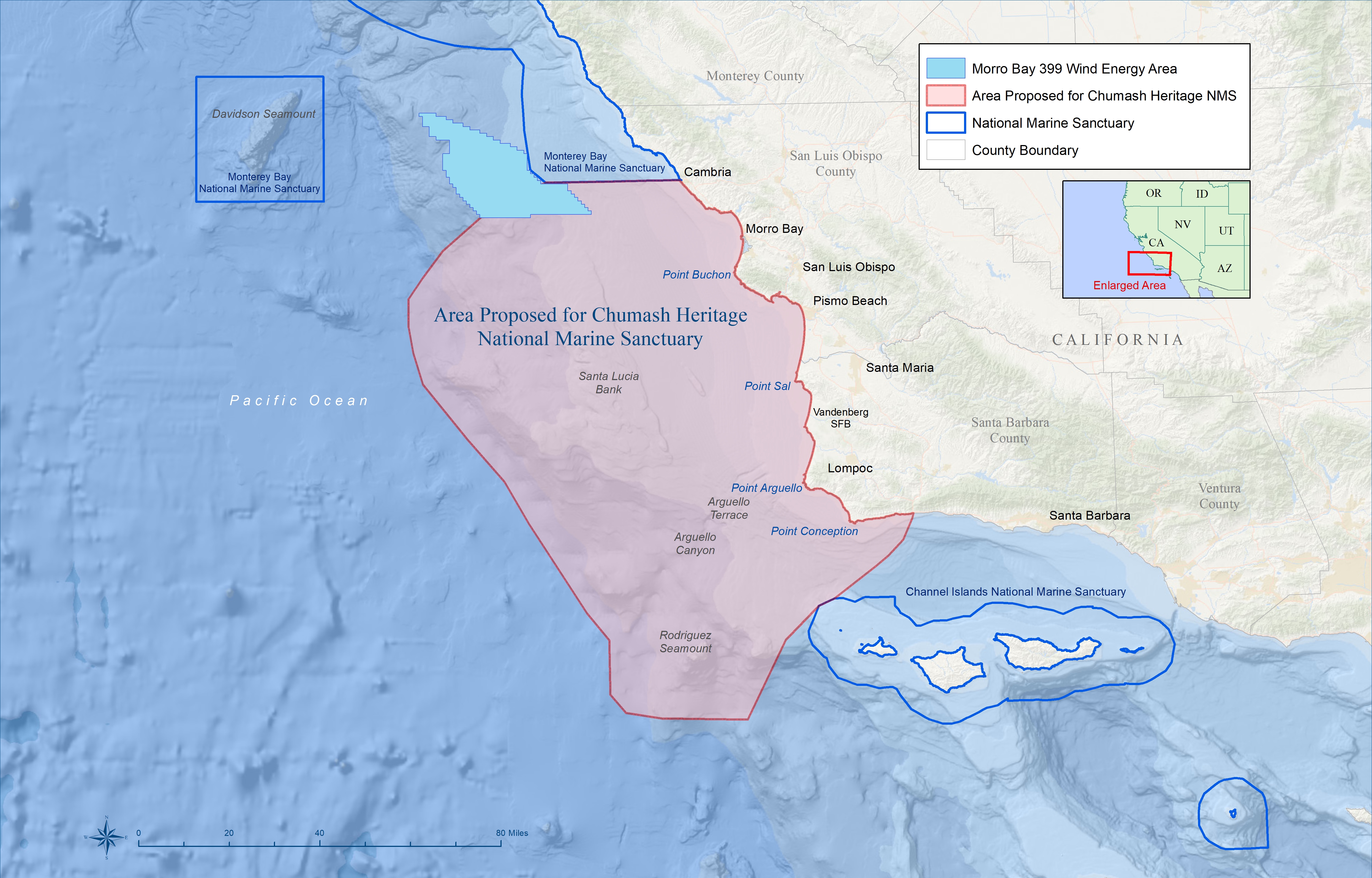By John Hankins
After forty years of region-wide advocacy, the federal government will advance the proposed Chumash Heritage National Marine Sanctuary to the ‘designation’ phase, making it the first tribally nominated sanctuary in the nation.
It would cover a 7,000 square mile area along 176 miles of the central California coast, adjacent to San Luis Obispo and Santa Barbara counties, tying in between the Monterey Bay and the Channel Islands marine sanctuaries.
The boundaries are adjusted to exclude a 400 square mile area for wind energy development, contributing towards the Biden Administration’s goal to deploy 30 gigawatts of offshore wind by 2030. That will also be part of public comments (see links below).

A diverse assembly of leaders and the public rushed to applaud the action. It will now enter the ‘scoping’ phase, which includes input from the public and is the first phase in a four-step process (see below for virtual meetings).
“I am thrilled the Biden administration has taken this step to protect our coastal areas from further oil and gas drilling and strengthen our state’s $1.9 trillion coastal economy, which is propped up by tourism and commercial fishing,” said Rep. Salud Carbajal. “Bringing the proposed sanctuary into the designation phase is the result of years of public engagement … I am also thankful for the steadfast leadership of the late Fred Collins, Chair of the Northern Chumash Tribal Council, whose legacy of advocacy was instrumental in moving this project forward.”
“(This) will protect ocean life, sacred Chumash sites, strengthen Indigenous communities and serve as a model of environmental justice,” said Violet Sage Walker, Fred Collins’ daughter and the current Tribal Chair. “Today my father would be proud. This is one of the things he wanted to see the most,” she added.
Thank local Democrat legislators, all of whom have been endorsed by the Sierra Club which strongly supported the sanctuary. They include Carbajal, and Senators Feinstein and then-Senator Harris. They succeeded in gaining a five-year extension from 2015, avoiding the Trump Administration’s likely rejection. In August, Carbajal led the charge to get it into the ‘designation’ phase.
The waters off the Central Coast are some of the most biologically diverse and ecologically productive regions in the world. The marine resources include feeding grounds for whales and dolphins, sea otters, kelp forests, and is home to vital commercial and recreational fisheries.
These resources are essential to California’s $1.9 trillion coastal economy and supports $731 billion in wages, according to NOAA.
“It’s impossible to fully calculate all the benefits the Central Coast will receive as a result of the ecosystem-based management that a national marine sanctuary brings,” noted Andrew Christie, director of the Santa Lucia Sierra Club.
“This proposal demonstrates the Biden-Harris administration’s commitment to lifting up community-led efforts to conserve our lands and waters and strengthen our economy,” said Deb Haaland, Secretary of the Interior. “Local voices, Indigenous knowledge, and collaborative stewardship will be integral to our efforts to bolster community resilience, protect our natural resources, and build a clean energy economy.”
Remarking on the recent oil pipeline break near Huntington Beach, no less than Brenda Mallory, Chair of the White House Council on Environmental Quality, said, “it’s a costly and harmful reminder that we need to do more to protect our coastal communities from the threats that our ocean is facing. The Chumash Heritage sanctuary proposal and the Morro Bay wind energy area provide an opportunity for communities to help shape how we both protect the region’s extraordinary marine and cultural resources and harness the ocean’s clean energy potential.”
Now it’s the public’s turn to weigh in, and as our Chapter vice-chair Jim Hines said, “So let's get comments in, supporting the sanctuary’s creation!”
The public can comment on the proposed sanctuary designation until January 10, 2022, through the Federal eRulemaking Portal at:
www.regulations.gov
The docket number is NOAA-NOS-2021-0080. It will also host virtual public meetings on Dec. 8, 13, and January 6 (2022) during which members of the public can offer oral comments.
A detailed description of the proposed sanctuary, as well as additional information about opportunities to provide comment, can be found at:
http://sanctuaries.noaa.gov/Chumash-heritage
Comment on Chumash Marine Sanctuary live on-line.
Virtual public meetings will be held in December and January to gather input on the scope and significance of issues to be addressed in the environmental impact statement that are related to designating this area as a national marine sanctuary. Deadline is Jan. 10, 2022. More details here:
http://sanctuaries.noaa.gov/Chumash-heritage
Wed., Dec 8, 6 – 9pm:
Register: https://register.gotowebinar.com/register/5934702389309680399
Mon., Dec 13, 1 – 4pm:
Register: https://register.gotowebinar.com/register/1642653198337341710
Thurs., Jan 6 (2022), 4 – 7pm:
Register: https://register.gotowebinar.com/register/2954174857204428046